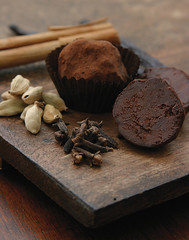 you learn so much about the history behind the food.I'm going to savour "one-by-one" the remaining books that I picked up on my "massive" cookbook haul this weekend. They are from Lousiana, the land that our government forgot. And, this particular cookbook highlights a portion of Louisiana's history and people that we might not have learned about and came to being completely wiped out during Katrina.Today...Los Islenos Cookbook. Carnary Island Recipes. Recipes from Spanish Louisiana. - $4.50Los Isleños Cookbook was first published by Pelican Publishing Company in 1998.
you learn so much about the history behind the food.I'm going to savour "one-by-one" the remaining books that I picked up on my "massive" cookbook haul this weekend. They are from Lousiana, the land that our government forgot. And, this particular cookbook highlights a portion of Louisiana's history and people that we might not have learned about and came to being completely wiped out during Katrina.Today...Los Islenos Cookbook. Carnary Island Recipes. Recipes from Spanish Louisiana. - $4.50Los Isleños Cookbook was first published by Pelican Publishing Company in 1998. The recipes in this book have come from many states and from as far away as Nicaragua, Spain, and the Canary Islands. They are, therefore, not all technically Spanish recipes. Those that are, can be found in the section entitled Canary Islands and Spain. Others handed down by Isleño ancestors can be identified by names such as Caldo and Paella and by reading the Spanish names and commentary of the donors throughout the various sections of the book. There are definite similarities between the Canarian and the Spanish recipes and the recipes of the Isleño descendants. Many of our best Isleño cooks were unable to provide written recipes when first asked. After all, good cooking just comes naturally. Excuses ran from, "I don't have any written recipes," to "I never measure, " and "I just throw it all into the pot." In those cases, we are deeply grateful to the "culinary secretaries" who observed and recorded these recipes for posterity.
The purpose of this book is two-fold: Firstly, to acquaint the general public with the relatively unknown Isleño culture and secondly, to raise funds for educational, historical and cultural improvements to the Isleño Museum and Village. Both are located in St. Bernard Parish, Louisiana, the home site of the Canary Islanders who settled there beginning in 1778.
The most successful of four original Isleños colonies in the region, San Bernardo (later Anglicized as St. Bernard) once supplied the city of New Orleans with many of its staple foods, when the Isleños were farming on tracts given to them by the Spanish government. Some Isleños soon consolidated those tracts into successful sugar plantations. After the Civil War, however, many Isleños retreated to the easternmost parts of St. Bernard Parish, forming such remote enclaves as Delacroix Island and Shell Beach.
“They were the ones who, because of their isolation, retained their cultural identity,” Hyland says. That meant speaking the same Spanish dialect they had spoken for generations and singing the same traditional decimas (native poetry sung a cappella). - American Profile
Drive deep into St. Bernard Parish, and you notice the names on the mailboxes: Nunez, Marrero, Estopinal, Rodriguez, Gonzales, Perez. Two-thirds of the parish's 70,000 residents are Islenos.
Like the population of French Cajuns farther west, Islenos came to Louisiana when it was a European colony. They stayed, and today they're a cultural island. - NPR
AVOCADO CAKE
- 2 cups sugar
- 3/4 c. shortening, creamed
- 3 eggs
- 2 cups flour, sifted
- 3 tsp. cinnamon
- 3/4 tsp. salt
- 3/4 tsp. allspice
- 1 1/2 tsp. baking soda
- 1 1/2 cup avocado, pureed
- 3/4 cup buttermilk
- 2 tsp. vanilla
- 3/4 cup raisins
- 1/2 cup nuts, chopped
Preheat oven to 350 degrees. Add sugar slowly to softened shortening. Mix until light and fluffy. Add eggs, one at a time, mixing after each addition. Sift together flour, cinnamon, salt, allspice and baking soda. Fold into egg and sugar mixture. Approximatley 1 Florida or 2 California avocados will yield 1 1/2 cups of puree. Add pureed avocado, buttermilk and vanilla. Add raisins and nuts. Grease and flour 2 (8 1/2 x 4 1/2 x 2 5/8 inch) loaf pans. Pour in batter. Bake at 300 degrees for 60 to 65 minutes.




















